FTC Disclosure: Delicious Obsessions may receive comissions from purchases made through links in this article. As an Amazon Associate I earn from qualifying purchases.Read our full terms and conditions here.
{Today, I am excited to welcome Tessa from Homestead Lady to the site! She is sharing a great post on medicinal herbs that will grow in the shade. This is super helpful for me, as my backyard is on the north side of the house and gets very little sun. I hope you enjoy! ~Jessica}
I am an herb girl, through and through. Herbs are versatile in the garden, looking equally lovely mixed with turnips or tulips. They are useful in the kitchen and the home remedy cabinet. They can also be used to create beautiful dyes for your home crafts and children’s projects.
Some of us struggle with herbs, though, because we feel that the really useful ones grow only in the sun and we’ve maxed out our bright spots with big, fat sun pigs like pumpkins and tomatoes. Never fear! May I introduce you to five medicinal herbs for the shade AND dye pot?!
DISCLAIMER: The content shared on this site is for informational and educational purposes only. Statements/products discussed have not been evaluated by the Food and Drug Administration (FDA) and are not intended to diagnose, cure, treat, or prevent any disease or illness. Please consult your own certified health care practitioner before making changes to your current diet or before beginning any herbal or vitamin supplement regimen or exercise program.
Five Medicinal Herbs for the Shade and Dye Pot
Hops Vine
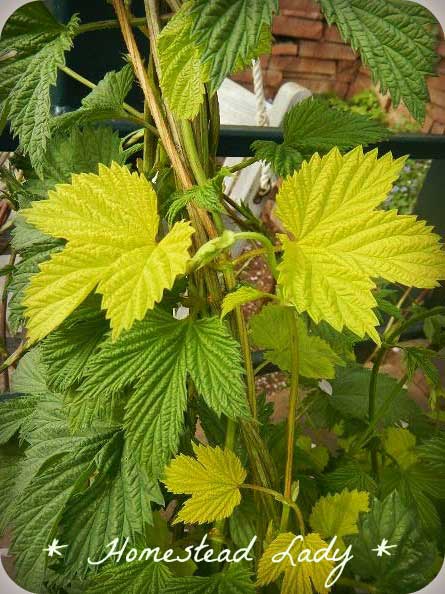
First up, we have Hops (Humulus lupulus), which is a vine that any traditionally prepared beer drinker has already learned to appreciate; hops flowers have been used to give beer its distinct flavor and aroma since the Middle Ages.
Herbal gardeners should learn to love it, too, as it is a vigorous and lovely vine which produces the easily recognizable cone-like flowers. The vines of the hops plant can be used to make baskets and wreaths. The leaves and flowers can be collected to produce dyes that color in tans and browns. The perennial vine dies back each winter to return and grow upwards of 30 feet per year – so have a sturdy trellis or arch for it to cover! Hops likes loamy, well watered soil and can thrive in full sun or partial shade – the vine will still be vigorous in fuller shade but there can be fewer flowers.
Typically, the strobile (flower cluster) is used medicinally but you can also dry the leaves. Hops is commonly used in dream pillows along with lavender as it has a soothing, sedative effect. You can also brew a tea with it for restlessness, insomnia and to ease the digestive tract with complaints like IBS. Ironically, the female flower is believed to aid against alcoholism. Because it has narcotic qualities, you should use hops in moderation and don’t use it for very long; people who suffer from depression should not use it at all.
Blackberry
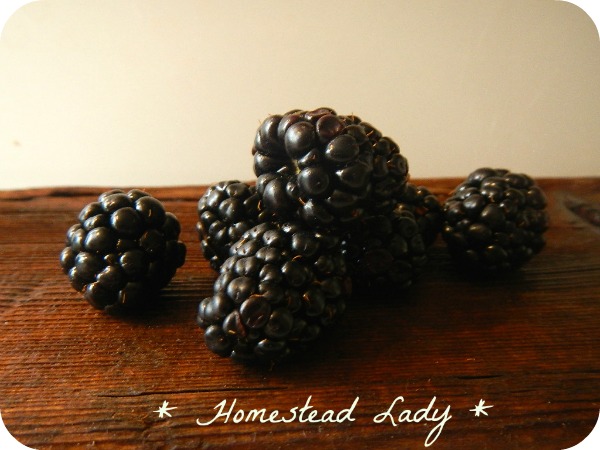
I used to live in North Carolina, USA, and I can tell you that blackberries will most definitely grow and produce in the shade – everything in the southern states is under a canopy of trees!
Blackberry brambles grow wild up and down North and South America and are cultivated in backyards around the world. They are a cane plant, which means that blackberry resembles and bunch of thorny sticks coming up from the ground looking very much like a bad hair day. You can train blackberry to a trellis if you don’t fancy fighting through the canes to find your fruit and leaves.
The berries are, duh, great to eat out of hand or to throw into homemade ice cream. And then bring to my house. 🙂 The berries also make a very fine rose to purple colored dye. Berry dyes are fun to play around with and I encourage you to try a few dye experiments with leftovers from the harvest this year. The leaves are typically used as a home remedy for diarrhea and to generally calm an upset digestive tract. Be sure to use some raw honey in your tea – the leaves are a bit on the astringent side!
Oregon Grape
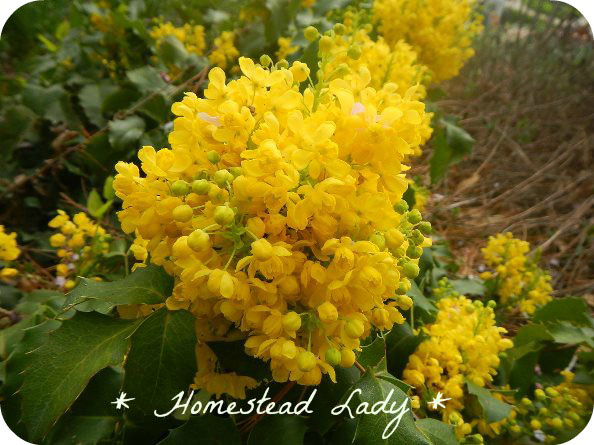
Ok, I admit that this next one is not THE best dye plant in the world but, if you’re lucky enough to be able to grow it, give it a try!
Oregon grape (Mahonia aquifolium) is a plant that actually thrives in shade and, for that reason alone, I believe it has a place on this list! The plant itself can be low growing or quite bushy, depending on soil; Oregon Grape prefers the soil to be well drained and humusy. It is often mistaken for holly because of its lovely, holly-shaped leaves. Instead of bright red berries like holly, though, it sports deep, indigo colored berries that come after fragrant, yellow bell-shaped clusters of flowers fade.
The berries make a yummy syrup or can be dried to eat out of hand or added to smoothies. The berries also make a nice purple dye and the roots or Oregon grape will make a decent yellow. The dilemma here is that you’d have to dig up a lot of roots to make a good color and you’d probably be better off drying them for your herbal teas when you need an immune booster or a little liver tonic. Either way, this sweet little plant deserves a look if you’ve got shade in the garden.
Bee Balm
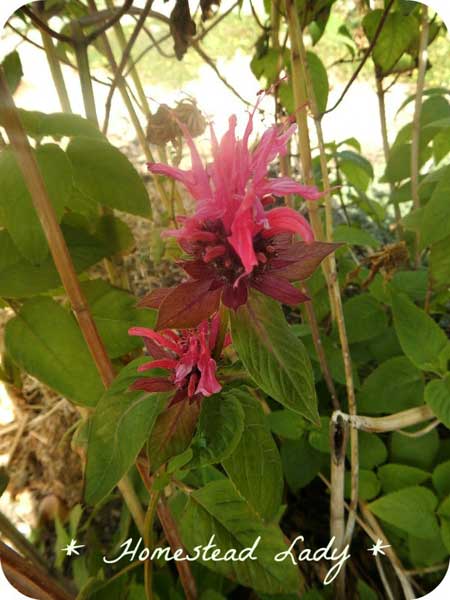
Bee Balm or bergamot (Monarda didyma) is a great plant to have in the garden just because its hardy and happy!
Students of the American Revolution may remember this herb because it was one the colonists used to replace the China tea they had previously purchased from England before the boycotts that lead to the infamous Boston Tea Party. Who knew herbs could be subversive?!
Bee balm is a true American wildflower and you can tell by its smell that bee balm is related to mint. Like most mints, bee balm will soothe a sick tummy from gas to vomiting, if you use the leaves and flowers in a tea. The flowers, which are usually red or pink (although, I have a lavender one in my yard – cheeky bugger) can be used to make a very fine salmon/pinkish dye. Like all natural dyes, you need a good deal of the flowers to make a strong color so let bee balm wander all over your yard, which it will do wherever the ground is moist.
Bee balm is a great plant for pollinators, as its name suggests. And, yes, bee balm will perform in sun or part shade; you will need some light if you want flowers but if you’re just looking for leaves, a little more shade should be fine.
Borage
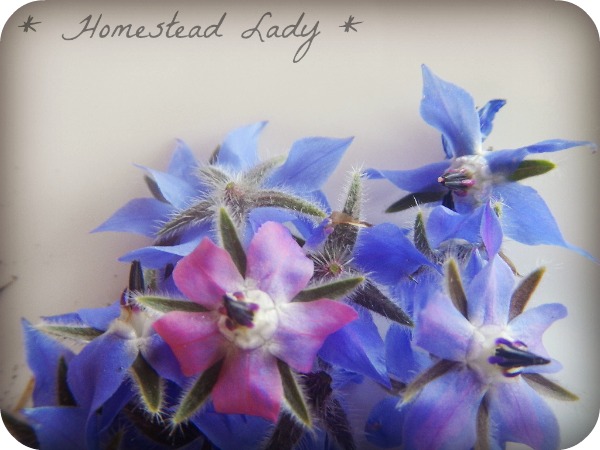
I love borage. I can’t help myself. It reseeds like a brother. It has prickly, painful stalks when its mature. And it can grow pretty wide and full, bullying my lettuces and carrots. BUT, borage (Borago officinalis) is simply one of the most attractive herbs, in my opinion.
Borage is a reseeding annual and it WILL reseed so pull the plant or cut the flower stalk before it goes to seed if you don’t want it growing everywhere. I feed the mature plants to my livestock since I have so many plants in my garden and it’s a favorite of my goats. Borage is one of the first things to come up in my yard every spring and since I do allow it to reseed, I always have more seedlings than I need; so our early spring, green salads are heavy with borage babies with their light cucumber/celery flavor. (Be sure to only use young borage plants for eating because the prickles get pricklier as the plant ages.) You can also wilt the leaves with spinach and eat them hot with butter.
Borage can do full, hot sun or some dappled shade; although I will say that I have some growing directly under a tree in full shade in my yard and it still flowers like crazy so take what you read in books and blog posts with a grain of salt! 🙂
Used medicinally for reducing fevers (you can feel its coolness on your tongue when you eat it fresh), restoring health after sickness, calming nervous conditions, and to stimulate lactation in nursing mothers, borage is a great plant to grow for your health. The leaves, flowers and seeds can all be used medicinally. The flowers are, perhaps, the most interesting thing about this plant as they change color from true blue to purple to pink as they age – they look gorgeous in a salad or sugared on a cake! A purple/blue dye can be made from the roots and flowers, unless you add an acid, in which case the dye bath turns pink. Random fact: borage is related to alkanet, another dye plant.
So, there you have it – a tidy list of five medicinal herbs for the shade and dye pot! Do you have a favorite that I missed? I’d love to know about because, let’s face it, you can never have too many herbs. Or dye baths. Leave a comment below!
Happy Gardening!
Supporting a The Adrenals, Thyroid, and Whole Body Through Herbs
When it comes to supporting overall wellness, herbs are a great tool to have in your toolkit, especially those who may be dealing with chronic illness of some type. Since 2009, when I started this site, I have met thousands upon thousands of people through my work and by far, the #1 health complaints are:
- adrenal fatigue (or adrenal dysfunction of some sort) (click here to read all of my adrenal health articles)
- thyroid disorders (hypo-, hyper-, or autoimmune) (click here to read all of my thyroid health articles)
Because of this, I wanted to add in a section into this post about the benefit of using herbs with chronic illness.
If you are dealing with any type of chronic illness, I’m sorry to break it to you, but caffeine may not be your best friend. 🙁 While you can find lots of info online in both the pro- and the anti-coffee camps, the fact of the matter comes down to the fact that are a lot of people dealing with chronic illness, especially thyroid and adrenal problems, that simply cannot tolerate coffee and caffeine.
While those with sluggish adrenal glands tend to feel run down and in need of a regular pick-me-up (like coffee and other caffeinated beverages), in the long run, caffeine can do more harm than good while you are healing. I go into the “whys” around caffeine and your adrenals in this detailed post here. In addition to the caffeine, there are other constituents, molds, and mycotoxins that can show up in coffee that some people find they react to and can further exacerbate the toxic load on the body.
When I was diagnosed with autoimmune disease and adrenal fatigue, one of the first things that had to go was coffee. In addition to dealing with these issues, we suspected that I was having some detox pathway sluggishness so we wanted to also focus on supporting the liver and lymph systems. Most people who are dealing with chronic illness are also going to have issues with detoxification of the body, which is why herbs can play such an important role.
To be honest, I never drank coffee because of the caffeine. I drank coffee for the taste and aroma, as well as the emotional experience I felt to my morning cup of joe. For me, it was a ritual that I looked forward to every day (and sometimes multiple times a day). Whether I was brewing it at home or going to my local coffee shops, the experience was one that I clung to tightly.
But, when I was faced with new health struggles, I knew I had to do whatever I could to support my body and give it the tools it needed to heal. Giving up coffee and caffeine was one step in this direction.
And it sucked.
I turned to the coffee substitutes on the market in a desperate attempt to recreate the ritual I had grown so fond of, but nothing ever tasted the way I wanted it to. Nothing ever gave me that same experience that my cup of “real” coffee did. I knew there had to be something better, but I simply could not find it on my health food store’s shelves.
Necessity is the mother of invention so that is why I created my own coffee substitutes. They were made with organic, sustainably harvested herbs with zero grains, zero gluten, and zero caffeine. Just herbs.
Herbs that not only tasted delicious but supported my body’s function, like liver detox, bile production, digestion, etc. All of the herbs used in my “coffee” blends have been used for thousands of years to support the body’s normal functions and help everything work a little better — something we all need in today’s toxic world! (psst, dandelion is one of the herbs!)
When it came to creating these blends, if I could get something to not only tasted amazing (and helped me recreate my dearly loved ritual), but also did amazingly supportive things for my body, then it’s a no brainer!
I sold these pre-made blends on Etsy for awhile and the demand was more than I could keep up with. People literally LOVED these blends and were stunned at how much like coffee they actually tasted. Customers who had been dealing with a variety of chronic illnesses had given up coffee to heal their bodies, but like me were deeply missing their morning cup of joe ritual.
After careful consideration and work with some highly experienced advisors, I decided to stop selling the pre-made blends and instead share my proprietary recipes in the form of an eBook. That way I could arm people with the knowledge and recipes they needed to make their own caffeine-free, gluten-free, grain-free blends in the comfort of their own home.
That is why I created the best-selling DIY Herbal Coffees eBook: A Complete Guide To Making Delicious Herbal Coffees to Support Healing & Stress Relief.
Now in its second edition, this ebook features:
- All of my proprietary herbal blend recipes to you can craft a homemade herbal cup of “coffee” at home.
- A ton of researched information about coffee’s impact on the health of those dealing with issues like adrenal fatigue, blood sugar dysregulation, autoimmune disease, thyroid disease, and any other chronic illness.
- Information about all of the herbs used, why I selected them, how to source them, how to prepare and store you “coffees”, and much more.
- Access to your own personal coffee shop where I show you how to recreate your favorite coffee shop drinks and pastries with wholesome, nourishing real food ingredients. No junk here. Only real food.
This book truly is a comprehensive guide to supporting your health, reducing your stress, and bringing a little something special back into your healing journey. You can learn more and download your own copy of this revolutionary wellness guide here, or simply click on the image below.

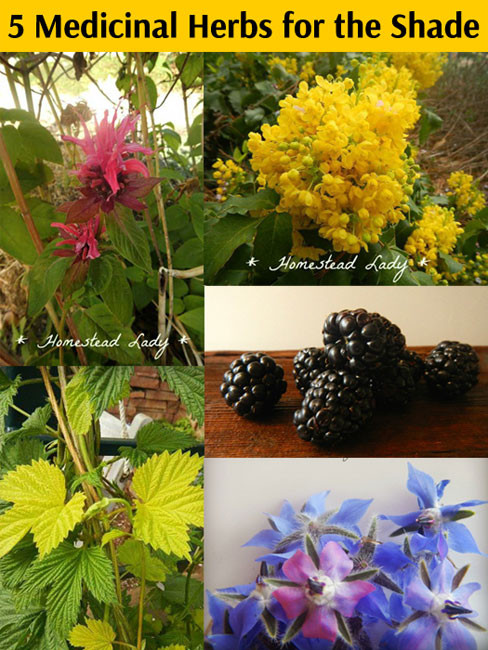
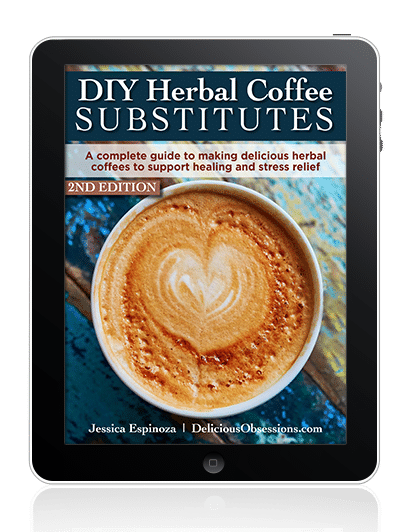

4 Comments